
|

|
|
Home Site Search Contact Us Subscribe
|
|
|
Who Designed the Space Needle? Victor Steinbrueck's contributions have been given short shrift, leaving the design of what is arguably Seattle's most important structure clouded by assumption and innuendo to this day. By Dale Cotton May 11, 2012 Who designed the Space Needle? One answer lies in the handwritten memoir by Victor Steinbrueck. He picked up his pen on December 8, 1961, the day the last piece of steel was raised to the top of the platform. “My Space Needle Story,” a 20-page handwritten memoir to his children, explains in detail how the final design came about. Why did he find the need to write this story? Probably because he wasn’t given his due as an architect of the Needle, which was built to highlight the 1962 Century 21 Exposition in Seattle.
A Collaborative Effort
John Graham, Jr., the architect-of-record, hired Steinbrueck to create a structure that could be engineered to support a revolving restaurant. Yet, once it was completed Graham said the result was a collaborative effort among the designers at his firm, John Graham & Company.
Graham was listed as the designer in the official document handed out to the press at the fair (Official Press Book: Seattle World’s Fair 1962). Not a surprise. The architectural firm of record is typically given design credit rather than a specific architect. Since Steinbrueck was brought in to work on that one project for Graham’s firm, only the detailed architectural records show that Steinbrueck contributed to the design. And even those records do not break it down into who did what. Steinbrueck’s contributions have been given short shrift, leaving the design of what is arguably Seattle’s most important structure clouded by assumption and innuendo to this day.
Steinbrueck’s story, written on National brand Made-in-the-U.S.A. “Easy on the Eyes” graph paper and accompanied by several design sketches, is significant not merely because it attempts to set the record straight. It is the back-story to the design process of Seattle’s most iconic structure, which was named a city historic landmark in 1999 and is now celebrating its 50th anniversary year. The story records his working relationship with Graham and other members of the staff, and gives a clear indication of who contributed and who didn’t.
Design Evolution
The Space Needle passed through many iterations in its evolution from a balloon in the sky to the high-waisted tripod that is its final form. Eddie Carlson, a Seattle business executive and major civic leader, was appointed by the governor to chair a commission to study the feasibility of mounting a world’s fair in Seattle. The story goes that when Carlson visited Stuttgart, West Germany, in 1959 he saw a television tower whose ambitious height and futuristic top housed a restaurant inspired his vision for the Space Needle. And when he returned to town he supposedly doodled the idea on a napkin – a tall spire topped by a restaurant. Carlson re-created the doodle later and it is now part of the Needle history (or lore).
Fair promoters then asked Seattle architect John Graham, Jr. to translate this idea into a finished design. Known as a “businessman’s architect,” Graham could be counted on to make his projects pay for themselves. He had also recently completed a design for which he was issued a patent – a revolving restaurant atop a shopping center in Hawaii. He was the obvious choice in Seattle, since Carlson coveted a spinning restaurant in the sky.
Graham asked his team of designers to think up some schemes for the structure. They worked up two ideas in 1959 that had some merit in Graham’s eyes: a balloon-inspired dome held up by stay wires, and a thin space-disk restaurant on a slender spire. But with his designers committed to other projects, Graham brought in Steinbrueck, an architecture professor at the University of Washington, to work out new designs for the structure’s form in the summer of 1960. Steinbrueck entered into the thick of what was at the time a pie-in-the-sky idea, where the site and funding for a hoped-for tower for Century 21 were still, so to speak, up in the air.
Graham stressed that “he didn’t want to set the world on fire but to do a good tower,” according to Steinbrueck. Steinbrueck, on the other hand, anticipated the importance of such a structure and “felt very strongly that the tower should express (amongst other things) the most advanced and imaginative structural concept possible at the time. It should be a demonstration of progressive technology and point a direction for engineering.”
Steinbrueck Starts to Draw
Steinbrueck’s hundreds of drawings over the summer were critiqued only by Graham, leading him to believe that it was Graham’s assertive control over the project that pushed the staff away from contributing more. Working from an aisle desk with high visibility in Graham’s office, Steinbrueck received many comments in passing, but ”while criticisms or opinions were given freely, often in jest, very few ideas were given.”
According to an important book publication produced at the time (Space Needle USA, p. 21), “Steinbrueck tried other forms, a Stuttgart-like round chimney of reinforced concrete, a modified transmission tower with house on top, an upended torpedo with supporting legs, a flower-like base on the bottom of the cruciform shaft, a triangular spire tapered to a sharp point, on which was impaled a basket-like house. Graham leafed through them and shook his head.”
Nothing much passed muster, other than a design using a tension-wire technology suggested by one of Graham’s engineers. Graham liked it as did other staff members, and Steinbrueck developed it further. But Fair officials still preferred the tapered tower idea that had preceded Steinbrueck’s input, so they vetoed the tension-wire idea as too “daring.”
Pressured at the firm to work only on schemes that Graham and others pushed, Steinbrueck found more breathing space away from the office. It was while working from home in early August that he sketched the “essential structural concept and basic form that has become the Needle.”
A Sculpture Beckons
All those months the sculpture beckoned from a shelf in his home office. Finally its potential hit him like a lightening strike. He could translate the tension he saw in the sculpted form in front of him into the Needle structure. David Lemon’s dynamic sculpture, “The Feminine One,” depicted a dancer in motion. In Steinbrueck’s scheme the dancing figure became “three figures leaning back together against the core which was to be minimized and separate in feeling.” He drew it up and took it back to the office with full confidence that Graham would like it, which he did. The only problem was finding an engineer and construction firm to make this difficult form a reality.
Changes were made in between the initial concept and the final form to make construction feasible, but most were minor. That left only the top house to consider. Steinbrueck says his working relationship with Graham was amiable throughout, but the one component that caused some tension between the two was the top house, about which Graham had strongly felt ideas. Steinbrueck was “aware that he [Graham] wanted something that I was not willing to design,” so in the end staff architect John Ridley fine-tuned Graham’s saucer idea that became the top house’s final form.
Steinbrueck’s preferred form and top house is seen in his Aug. 24, 1960 drawing reproduced here. In it “the tower is higher waisted . . . with a simpler top house and more elements in the shaft.” He wanted viewing platforms at 200 and 300 feet for several reasons: structural soundness; people standing at different levels provided scale; and the spectacular views would be varied.
Privately owned and operated to meet the monetary needs of its owners, the Space Needle has been subject to a kind of Lego effect over time. In the early 1980s a “SkyLine Level” was added at the 100-foot mark to house banquet facilities. The new facility juts out from the struts, interrupting the flow of the finely conceived tripod legs and negating some of the top house’s prominence.
Design Credit Spotty
The huge success of the Fair and the renown gained by the Space Needle over the succeeding years made the tower ever more important. Credit for the design has proven spotty.
Perhaps the most definitive version of the events, published by historian Walt Crowley (in his 1999 HistoryLink.org entry), is that the Space Needle “was conceived by Eddie Carlson (1911-1990) as a doodle in 1959 and given form by architects John Graham, Jr. (1908-1991), Victor Steinbrueck (1911-1985), and John Ridley.”
Steinbrueck would most likely contest the fact that Graham and Ridley were given equal billing with him in creating the form. In his 1989 book Through the Eye of the Needle, Bill Speidel, a local newspaperman, raconteur, and good friend of Steinbrueck, claims that Steinbrueck “took the trouble of calling me from his deathbed to make sure I didn’t credit Graham.” Even if in jest, that’s how important it was to him.
To be fair, Victor Steinbrueck did not conceive of the idea for the Space Needle and did not design the top house. Nor did he lobby for credit for either one. What he did design is the elegant tripod form, however, and he had much to say about the top house.
But the restaurant was Graham’s baby. As part owner of the Space Needle, he likely saw the top house as a potential cash cow after the fair closed its doors. At the same time, his revolving restaurant on top of the Honolulu hotel looked like it was plopped there as an afterthought. And as the designer of the first suburban shopping center concept in the country at Northgate Center, pragmatism was arguably more important to Graham than aesthetics. But he deserves much credit for knowing he needed Steinbrueck’s input on the Space Needle form.
Steinbrueck, who later saved the important community-oriented Pike Place Market from sure destruction, may not have been compatible with the man whose motto was Business First. Yet Steinbrueck says that Graham’s “criticisms were apt and perceptive and of value.” But he did not “believe that Graham ever suggested a form for the tower.” And that form spans over 500 linear feet of the 605-foot tower, a large chunk of the structure. Whatever their philosophical differences, “My Space Needle Story” makes it clear that the top house design should be credited to Graham and his staff, but that the final form of the tower came from Steinbrueck’s imagination.
Dale Cotton is a Seattle photographer and writer specializing in the built environment. His book, Princeton Modern: Highlights of Campus Architecture from the 1960s to the Present – a walking tour of the modern campus – was published in 2010.
Note: Special thanks to Peter Steinbrueck for allowing access to his father’s personal story, and to B.J. Bullert for her editorial comments.
|
(click on pictures to enlarge) 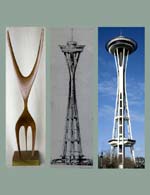 Drawing courtesy of University of Washington Special Collections Division; photo composite by Dale Cotton Victor Steinbrueck perceived a tension in the David Lemon sculpture that could benefit the Needle’s form. Included here is Lemon’s sculpture, Steinbrueck’s preferred Needle form, and today’s Space Needle. 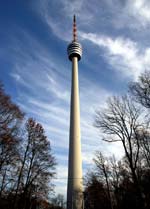 Photo courtesy of Wikipedia Commons Eddie Carlson, Fair chairman, saw a television tower topped by a restaurant in Stuttgart that he thought would make a great addition to Seattle’s Century 21 Exposition. 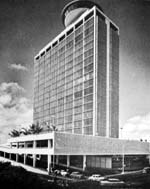 from "Space Needle USA," text by Harold Mansfield; photography by George Gulacsik (Seattle, WA: Craftsman Press, 1962) John Graham, Jr.’s revolving restaurant in Honolulu made him a prime candidate for making Carlson’s dream a reality in Seattle. 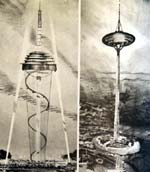 from "Space Needle USA" Two of many ideas preceded Steinbrueck’s design input: a tethered balloon and a space ship on thin spire. 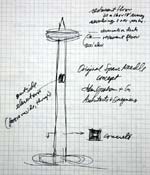 Courtesy of Peter Steinbrueck This Washington Monument-type spire, with an outside elevator and concrete rectangular core, was approved by the Fair organizers but ultimately rejected by Graham. “My Story” sketch by Victor Steinbrueck. 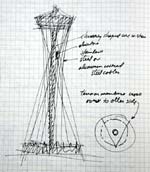 Courtesy of Peter Steinbrueck Steinbrueck’s “My Story” sketch illustrates one of his early designs that had promise – crossed tension wires enclose an elevator and stairwell. 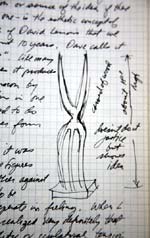 Courtesy of Peter Steinbrueck Steinbrueck’s “My Story” sketch of “The Feminine One,” which he says “produces extreme visual tension by constricting the form in one section.” 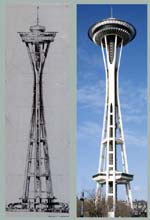 Courtesy of University of Wash¬ington Special Collections Division Steinbrueck’s drawing from August 24, 1960, when juxtaposed with the view today, shows a more proportional structure with multiple viewing platforms and a smaller top house. |
© 2012 ArchNewsNow.com